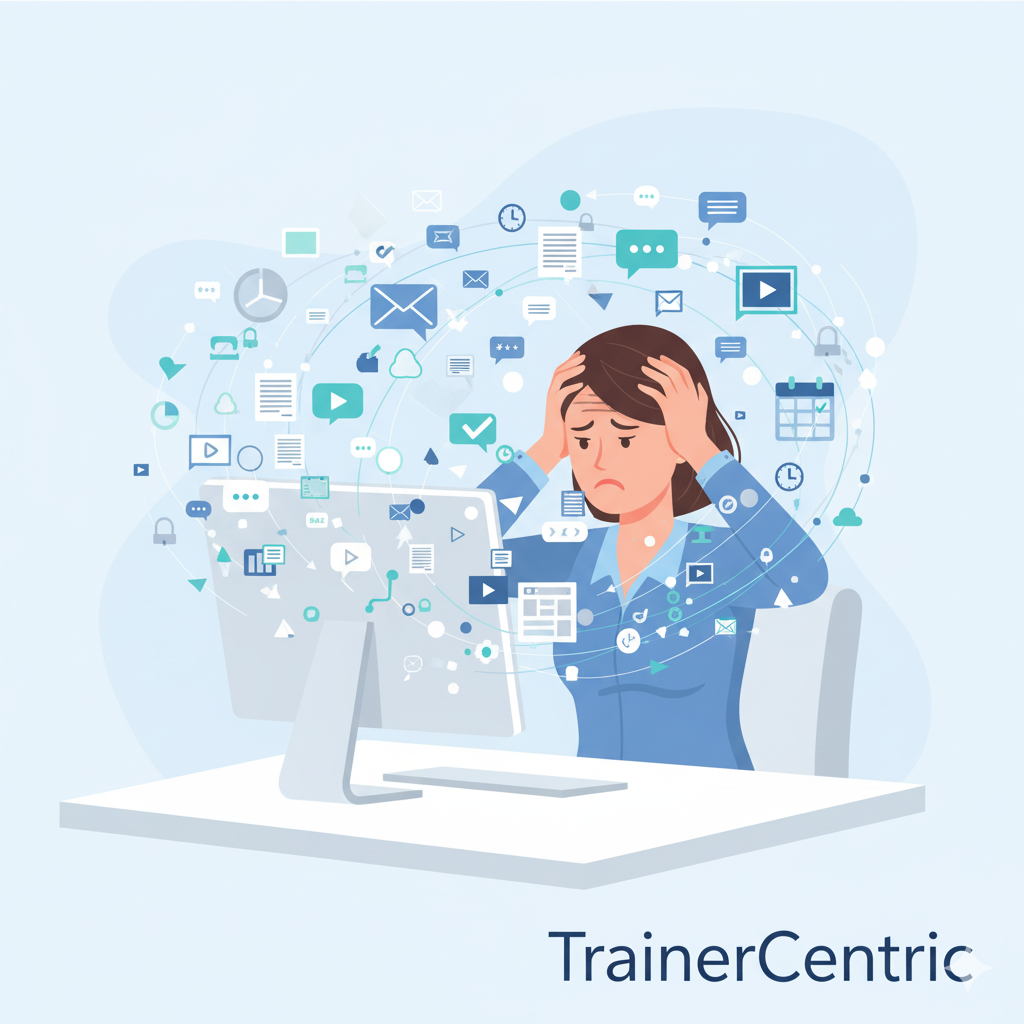Picture this: you’ve rolled out a sleek new microlearning module. It’s short, beautifully designed, and checks all the boxes. But when you look at the reports—learners are still struggling. Completion rates are low, knowledge retention is poor, and feedback says the content feels overwhelming.
What went wrong?
The culprit is often microlearning cognitive load—when learners face too much mental effort at once, even in bite-sized training. Instead of making learning easier, poorly designed microlearning risks becoming just another digital distraction. Most trainers don’t realize that microlearning cognitive load is often the hidden reason behind poor learner engagement. One of the biggest challenges in digital training is managing microlearning cognitive load effectively. When microlearning cognitive load is ignored, learners may feel overwhelmed instead of empowered.
The good news? With the right strategies, you can reduce cognitive load in microlearning and make your training sessions genuinely impactful. In this definitive guide, we’ll unpack Cognitive Load Theory in learning, why microlearning sometimes fails, and give you 7 powerful, practical strategies you can start applying today.

Understanding Cognitive Load Theory in Microlearning
To design effective modules, you need to understand how microlearning cognitive load interacts with working memory. Before diving into strategies, let’s simplify what Cognitive Load Theory (CLT) means in practice.
When learners process new information, their working memory has limits. Overload it, and they shut down. CLT breaks cognitive load into three types:
- Intrinsic Load – The natural difficulty of the subject matter. For example, learning advanced data analysis is inherently harder than learning how to mute yourself on Zoom.
- Extraneous Load – The unnecessary “noise” that distracts learners. Think cluttered slides, long-winded explanations, or irrelevant examples.
- Germane Load – The productive mental effort that helps learners build understanding and apply knowledge. Understanding intrinsic, extraneous, and germane load is key to mastering microlearning cognitive load in corporate training.
The secret to effective microlearning design is to manage intrinsic load, cut extraneous load, and maximize germane load. Researchers consistently highlight that microlearning cognitive load must be managed for true knowledge transfer.
When trainers ignore these microlearning cognitive load principles, that’s when microlearning fails.
Why Microlearning Fails Without Managing Cognitive Load
Microlearning is often sold as a magic solution—shorter lessons, higher engagement, better results. But in reality, many initiatives flop because the design ignores cognitive load theory in learning. Let’s look at how this plays out in practice.
Case Example 1: Compliance Training Gone Wrong
A financial services company rolled out a microlearning program on anti-money laundering. Each “short” video crammed 12 regulatory requirements into a 5-minute clip. Learners felt bombarded and couldn’t recall the details needed during real audits.
- Consequence: The company spent thousands on development but failed its compliance check because employees couldn’t apply the knowledge when it mattered.
The compliance module overloaded learners with legal jargon, showing how unchecked microlearning cognitive load can sabotage outcomes.
Case Example 2: Product Training Overload
A global tech firm created microlearning modules to train sales reps on a new product line. Instead of focusing on key differentiators, the modules overloaded reps with every technical specification.
- Consequence: Reps froze in client meetings, unsure what to highlight. Sales performance dipped, and trainers had to go back and redesign the program—doubling costs.
Case Example 3: Onboarding Chaos
An e-commerce company tried to shorten its onboarding by replacing a 3-day classroom session with 40 microlearning modules. New hires had to complete them all in their first week, without clear sequencing or scaffolding.
- Consequence: Learners felt overwhelmed, skipped modules just to “get through,” and left feedback that the program was confusing. Attrition in the first 90 days spiked.
Each of these cases shows what happens when microlearning cognitive load isn’t managed properly. Ignoring microlearning cognitive load not only overwhelms learners but also wastes valuable training budgets. New hires dropped off because the microlearning cognitive load was too high from day one
The Bigger Problem
When microlearning fails, the consequences go beyond poor knowledge retention:
- Wasted Budget: Companies pay twice—once for development, again for redesign or re-delivery.
- Learner Frustration: Overwhelmed employees lose trust in training programs, seeing them as a chore instead of support.
- Resistance to Future Training: Once burned, learners resist engaging with future initiatives, no matter how well-designed.
This is why applying strategies to reduce cognitive load is non-negotiable. Without it, microlearning risks becoming yet another L&D trend that fizzles out instead of driving performance.
7 Proven Strategies to Reduce Cognitive Load in Microlearning
Let’s get into the actionable part: how to actually simplify microlearning content and make it stick.
1. The Chunking Principle: Break Content into Digestible Bites

Chunking is the backbone of reducing microlearning cognitive load. When you break down concepts into smaller parts, learners can focus without feeling mentally overloaded. It means dividing information into smaller, logical units that learners can process without mental overload.
Why it works: Chunking aligns with how our working memory organizes data. By grouping related information together, learners can understand, store, and recall content far more effectively.
Corporate Example (Before): A compliance module presents all 10 rules of workplace ethics in a single 5-minute video. The result? Learners either tune out or fail to recall specific rules when asked later.
After: The training is broken into 10 short micro-modules, each covering one rule with a quick real-life case scenario. For instance, “Conflict of Interest” is explained with a 90-second scenario of a manager hiring a relative, followed by a one-question quiz. Learners master each concept before moving on.
Industry Tie-Ins:
- Healthcare: Breaking down patient safety protocols into small steps (hand hygiene, medication checks, patient identification) rather than presenting a full checklist at once.
- Sales: Splitting negotiation techniques into bite-sized lessons like “building rapport,” “handling objections,” and “closing.”
Trainer Tip: When chunking, think one concept, one outcome, one micro-module. If your slide or screen feels cluttered, that’s a sign you’re trying to fit in too much.
2. Weed Out the Noise: Eliminate Extraneous Load
Extraneous information is a learner’s worst enemy. Weeding means stripping away unnecessary text, visuals, or steps that don’t add value to the learning outcome. Weeding out irrelevant details prevents unnecessary microlearning cognitive load. The cleaner the design, the easier it is for learners to absorb what matters.
Why it works: By eliminating distractions, you free up working memory so learners can focus entirely on the content that matters.
Corporate Example (Before): In an IT onboarding course, a module on ticketing systems includes every possible menu and shortcut in the software. Learners quickly feel lost.
After: The microlearning module highlights only the top 3 features employees need on Day 1: logging a ticket, updating its status, and closing it. A “learn more” resource is available for advanced functions but not included in the main training.
Industry Tie-Ins:
- Leadership: Instead of presenting 12 leadership theories in one module, focus on the 2–3 most relevant to the company’s culture.
- Customer Service: Skip the corporate history slide and dive straight into how to greet customers effectively.
Trainer Tip: Ask yourself: Does this piece of content directly help the learner perform better? If not, it belongs in a resource library, not in microlearning.
Weeding out noise prevents unnecessary microlearning cognitive load.
3. Use Dual Coding: Pair Visuals with Words
Learners process visuals and text in different channels of working memory. When used strategically, dual coding balances these channels and reinforces understanding. When used carefully, dual coding balances verbal and visual channels, helping manage microlearning cognitive load while boosting long-term retention.
Why it works: Simple visuals paired with concise explanations improve recall and prevent cognitive overload compared to long blocks of text alone.
Corporate Example (Before): A leadership training module includes three dense paragraphs describing emotional intelligence components. Most learners skim and miss key points.
After: The same content is turned into a clean infographic with four quadrants—self-awareness, self-management, social awareness, relationship management—each paired with a short real-world example.
Industry Tie-Ins:
- Healthcare: Showing an annotated diagram of protective equipment placement with a step-by-step caption.
- Sales: Using a flowchart of the sales funnel instead of long descriptions of each stage.
Trainer Tip: Avoid decorative visuals that don’t serve a purpose. Every graphic should answer this question: Does this make the concept clearer?
4. Scaffold Learning with Progressive Complexity

Dropping learners into the deep end often leads to disengagement. Scaffolding means building from simple to complex, giving learners confidence step by step. Scaffolding allows trainers to introduce complexity gradually, a proven way to reduce microlearning cognitive load for beginners while still challenging advanced learners.
Why it works: By easing learners in gradually, you reduce intrinsic load and maximize germane load. Learners stay engaged because each step feels achievable.
Corporate Example (Before): A cybersecurity training starts with advanced phishing detection exercises. Learners, especially non-technical staff, feel intimidated and frustrated.
After: The course begins with clear examples of basic phishing emails. Once learners master spotting obvious red flags, progressively harder examples are introduced, leading to real-world simulations.
Industry Tie-Ins:
- Healthcare: Teaching new nurses basic wound care before progressing to more complex emergency scenarios.
- IT: Training junior developers first on debugging simple errors before tackling system-wide performance issues.
Trainer Tip: Think of scaffolding as building a staircase. Each step should be challenging enough to stretch the learner but not so high that they stumble.
5. Apply the “Less is More” Principle in Multimedia
Animations, sound effects, and gamification elements are tempting—but overuse can overwhelm. Simplify microlearning content by using multimedia sparingly and with intention. Overly flashy elements increase extraneous processing, which leads to unnecessary microlearning cognitive load. Minimalist design keeps learners focused on the essentials.
Why it works: A clean design keeps learners focused on the learning objective instead of being distracted by unnecessary elements.
Corporate Example (Before): A safety training module combines animated characters, background music, pop-up text, and flashy transitions. Learners find it entertaining but fail to recall the actual safety steps.
After: A minimalist animation with clear narration walks learners through the “Stop, Drop, and Roll” procedure, reinforced with a short interactive quiz.
Industry Tie-Ins:
- Sales: A simple roleplay audio clip is more effective than a flashy video filled with animations.
- Leadership: A brief case study video with captions is more memorable than an overproduced documentary-style clip.
Trainer Tip: Before adding media, ask: Does this enhance clarity or just add decoration? If it’s the latter, cut it.
6. Use Retrieval Practice to Strengthen Germane Load

Learning isn’t about exposure—it’s about recall. Retrieval practice helps learners actively pull information from memory, strengthening retention. Retrieval practice doesn’t just improve recall — it balances intrinsic and germane load, helping optimize microlearning cognitive load for stronger application at work.
Why it works: Every time learners recall something, they reinforce memory connections, making it easier to retrieve the knowledge when needed.
Corporate Example (Before): A product training ends after listing features. Learners soon forget details.
After: The training includes scenario-based questions: “A customer says they need faster performance—Which product feature should you highlight?” Learners apply knowledge in context, improving recall.
Industry Tie-Ins:
- Healthcare: Quizzing nurses with “What’s the next step after checking patient vitals?” rather than showing them again.
- IT: Prompting helpdesk agents with simulations like “How would you respond to this error code?”
Trainer Tip: Retrieval doesn’t need to be heavy testing. Quick polls, flashcards, or one-question quizzes at the end of a module are enough to boost learning.
This strengthens germane load and balances microlearning cognitive load.
7. Personalize the Path: Adaptive Microlearning
Not all learners start from the same level. Adaptive microlearning adjusts content to fit the learner’s needs, reducing unnecessary load for experts and guiding novices at the right pace. Adaptive learning paths are one of the most effective ways to manage microlearning cognitive load, since they prevent both overload for novices and boredom for experts.
Why it works: Learners stay motivated because they aren’t bored by content they already know or overwhelmed by content that’s too advanced.
Corporate Example (Before): All new hires complete the same 10-module onboarding program, regardless of experience. Some feel it’s too basic, others feel left behind.
After: A diagnostic quiz personalizes the journey. Experienced employees skip ahead, while newcomers receive guided, step-by-step microlearning with extra practice.
Industry Tie-Ins:
- Healthcare: Experienced nurses skip modules on basic hygiene while new hires receive full training.
- Leadership: Senior managers skip foundational leadership theory while first-time managers work through all the basics.
Trainer Tip: Even if you can’t build full adaptive systems, offer optional “explore more” links. This gives advanced learners room to grow without overwhelming beginners.
Key Takeaways
- Cognitive load theory in learning reminds us that working memory is limited.
- To prevent microlearning from failing, we must chunk information, cut noise, scaffold difficulty, and simplify content.
- The 7 strategies to reduce cognitive load—from chunking to adaptive paths—ensure learners not only finish microlearning modules but also retain and apply what they’ve learned.
When applied consistently, these microlearning design principles transform bite-sized training into a powerful engine for workplace performance. If you don’t manage microlearning cognitive load, even the best design will fail. The strategies shared here are proven ways to balance microlearning cognitive load.
The Next Step in Fix Microlearning Cognitive Load
When you put these strategies into practice, you’ll notice microlearning becomes less about cramming content and more about creating clarity, confidence, and real workplace impact. To make things even easier, we’ve prepared a practical Microlearning Cognitive Load Checklist you can use as a quick reference while designing your next module.
It’s available inside the TrainerCentric Digest, where corporate trainers like you get proven tools, fresh ideas, and step-by-step resources to stay ahead. If you’d like to simplify your design process and keep your learners engaged, the Digest is the perfect place to start.
Conclusion
Microlearning has enormous potential, but without managing microlearning cognitive load, even the best-designed modules can overwhelm learners and fall flat. By understanding cognitive load theory in learning and applying proven strategies—like chunking information, weeding out noise, scaffolding complexity, simplifying multimedia, and encouraging retrieval practice—you can transform microlearning into a tool that truly drives performance. When you focus on reducing microlearning cognitive load, training becomes clear, concise, and actionable.
The real advantage of microlearning is unlocked only when microlearning cognitive load is carefully managed. The key is remembering that less is often more. When learners feel clear, supported, and engaged, they retain more, apply faster, and value the learning experience. The strategies we’ve covered aren’t just design principles; they’re practical steps that can make the difference between why microlearning fails and why it succeeds.
The difference between why microlearning fails and why it succeeds often comes down to how trainers handle microlearning cognitive load. If you want your training to be not just “short” but effective, focus on reducing cognitive load and creating space for learners to think, practice, and grow. That’s when microlearning stops being a buzzword and starts being a competitive advantage.

![The Power of Storytelling in Corporate Training: Igniting Success and Inspiring Growth [2023]](https://trainercentric.com/wp-content/uploads/2023/06/storytelling-1024x576.jpg)

